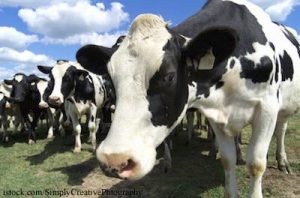The USDA has released more details about the case of bovine spongiform encephalopathy (BSE), commonly known as “mad cow” disease, that was found in a dairy cow in California. The government said the cow was “humanely euthanized” after it demonstrated “downer” behavior; that is, it stopped walking.
 This case was an “atypical case of BSE”, according to the government. That means it was a spontaneous mutation, not the result of the animal contracting the disease through contaminated feed.
This case was an “atypical case of BSE”, according to the government. That means it was a spontaneous mutation, not the result of the animal contracting the disease through contaminated feed.
BSE is caused by mutated proteins, called prions, which change the structure of the brain. This results in neurological damage. Prions are “a new frontier”, according to veterinarian Dr. Janet Tobiassen Crosby, editor of Veterinary Medicine at About.com.
Prions, technically known as “proteinaceous infectious particles”, are not alive, so they cannot be destroyed by heat, no matter how high the temperature. Chemical disinfectants do not kill the protein, and irradiation is also ineffective. BSE is a “zoonotic disease”, which means it is shared by human beings and animals. And the prions do not prompt a response in the immune system, so the diseases they cause are fatal.
The disease was discovered because the infected cow was being sent to a rendering plant, and was randomly chosen to be part of a testing program. Dr. Tobaissen Crosby told Food Poisoning Bulletin, “They do ‘random’ testing, so how can they say that it is 100% safe?” The brain sample was tested at the National Veterinary Services Laboratories in Iowa on April 20 after initial results at the University of California-Davis were inconclusive. The USDA’s Animal and Plant Inspection Service announced the test results on April 24, 2012.
She continued, “the FDA just released a statement that says ‘although current science suggests that atypical cases of BSE, such as this one, are unlikely to be transmitted through animal feed, the FDA will work with the USDA to complete a thoroughly epidemiological investigation.’ So they really don’t know how BSE is transmitted.”
As currently designed, the USDA program should detect one case of BSE in one million cows. All cows from highest-risk populations that exhibit BSE behaviors, including not being able to walk, cows older than 30 months, and those with strange behaviors such as agitation, are tested.
The USDA press release reiterated that it has three “interlocking safeguards against BSE that protects public and animal health in the United States.” Those are:
- Removal of specified parts of the animal that contain BSE from all slaughtered animals.
- Strong feed ban that protects cattle against the disease.
- Ongoing BSE surveillance program.
Consumer groups such as Consumers Union are concerned about this system for several reasons. They claim that the testing program is too small and that private companies should be allowed to test their own beef. They also don’t like that “remains of cows can be fed to pigs and chickens, and the remains of those pigs and chickens are fed back to cows.”
Finally, advocates are uneasy that there is no system that identifies and tracks each cow, although the USDA’s Animal and Plant Health Inspection Service (APHIS) has proposed a animal disease traceability rule that is now being fast-tracked after this latest discovery.




